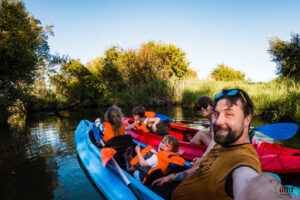Did you know that kayaking is not only a thrilling outdoor activity but also an opportunity to protect the environment? With the principles of Leave No Trace, kayakers can minimize their impact on nature and ensure its preservation for future generations.
This article explores the importance of eco-friendly kayaking and provides essential tips for responsible waste disposal, wildlife encounter etiquette, and preventing water pollution.
By adopting these practices, kayakers can enjoy their adventures while leaving behind no trace of their presence.
Key Takeaways Protecting the Environment While Kayaking Leave No Trace
- Following Leave No Trace principles is crucial for promoting sustainable practices in kayaking.
- Kayaking has a relatively small ecological footprint and produces zero carbon emissions, making it a sustainable choice.
- Kayaking can disturb wildlife habitats and cause erosion, so it’s important to minimize disturbance and avoid paddling in sensitive areas.
- Using biodegradable cleaning products, sustainable gear, and practicing responsible photography are important for minimizing the environmental impact of kayaking.
The Importance of Leave No Trace Principles
You should understand the importance of following Leave No Trace principles while kayaking. Understanding the environmental impact of our actions is crucial in promoting sustainable practices. When kayaking, it is essential to minimize our impact on the environment and leave it as pristine as we found it.

By adhering to Leave No Trace principles, we can protect sensitive ecosystems and preserve natural resources for future generations.
Following these principles ensures that we do not disturb wildlife or damage their habitats. It also means properly disposing of waste, including human waste, so as not to contaminate water sources or disrupt the ecosystem. Additionally, practicing responsible camping techniques, such as using established campsites and minimizing campfire impacts, helps prevent unnecessary damage to the environment.
Understanding the Impact of Kayaking on the Environment
Kayaking’s ecological footprint and the environmental benefits it offers are two key points that warrant discussion. Understanding the impact of kayaking on the environment is essential in order to mitigate any negative effects.

By examining its ecological footprint, such as carbon emissions and water pollution, as well as its positive contributions like promoting conservation efforts and fostering a connection with nature, one can gain a comprehensive understanding of kayaking’s overall impact on the environment.
Kayaking’s Ecological Footprint
Kayaking has a relatively small ecological footprint due to its low impact on the environment. Unlike other water sports that rely on motorized vehicles, kayaking is powered by human effort and does not emit harmful carbon emissions.

Here are three reasons why kayaking is considered environmentally friendly:
- Carbon Footprint: Kayaking produces zero carbon emissions since it relies solely on paddling. This makes it a sustainable choice for outdoor enthusiasts who want to minimize their impact on climate change.
- Sustainable Kayak Manufacturing: Many kayak manufacturers are adopting sustainable practices in their production processes. They use recycled materials, such as plastic bottles or fishing nets, to create durable and eco-friendly kayaks. Additionally, some companies implement energy-efficient manufacturing techniques to reduce their overall environmental footprint.
- Wildlife Conservation: Kayakers have the advantage of accessing remote areas without disturbing wildlife habitats significantly. The silent movement of a kayak allows nature enthusiasts to observe marine life up close while minimizing disturbance and preserving the natural balance of ecosystems.
Overall, kayaking offers an enjoyable outdoor activity with minimal negative implications for the environment.
Environmental Benefits of Kayaking
When kayaking, it’s important to be mindful of the impact we have on the environment. Kayaking offers several environmental benefits, especially when practiced with sustainable practices that minimize pollution.

First and foremost, kayaks are human-powered vessels, which means they do not emit any pollutants into the water or air. This makes kayaking a clean and eco-friendly mode of transportation on the water.
Additionally, by choosing to paddle in designated areas or following established routes, kayakers can help protect sensitive ecosystems and wildlife habitats from disturbance.
It is also crucial for kayakers to follow the principles of ‘Leave No Trace,’ which involves leaving nature as untouched as possible after each outing.
Essential Gear for Eco-Friendly Kayaking
When it comes to eco-friendly kayaking, there are several key points to consider.
One of these is using sustainable paddle materials, such as paddles made from recycled or renewable resources.
Another important aspect is using eco-friendly kayak accessories, such as seats and storage bags made from recycled materials.
Additionally, using biodegradable cleaning products for maintaining and cleaning the kayak helps minimize harm to the environment.
Sustainable Paddle Materials
To reduce your environmental impact while on the water, consider using paddles made from sustainable materials. Sustainable paddle manufacturing and eco-friendly paddle design are becoming increasingly popular as people strive to minimize their carbon footprint.
Here are three options to consider:
- Bamboo: Bamboo is a highly renewable resource that grows quickly and requires little water or pesticides. Paddles made from bamboo are durable, lightweight, and have excellent performance on the water.
- Recycled Materials: Some manufacturers produce paddles using recycled materials such as plastic bottles or reclaimed wood. These innovative designs help reduce waste and give new life to discarded materials.
- FSC-Certified Wood: Look for paddles made from wood certified by the Forest Stewardship Council (FSC). This certification ensures that the wood comes from responsibly managed forests, promoting sustainability in the industry.
Eco-Friendly Kayak Accessories
Consider purchasing eco-friendly accessories for your kayak to reduce your environmental impact. Sustainable kayak manufacturing and eco-friendly fishing techniques are important steps towards protecting the environment while enjoying water activities.
When it comes to kayak accessories, there are several options that prioritize sustainability. Look for paddles made from recycled materials or sustainably sourced wood. Additionally, consider investing in a dry bag made from recycled plastic, which helps minimize waste and pollution. Another eco-friendly accessory is a solar-powered phone charger, allowing you to stay connected without relying on non-renewable energy sources.
By choosing these environmentally conscious accessories, you can contribute to the preservation of our natural resources and promote sustainable practices in outdoor activities.
Transitioning into the subsequent section about ‘biodegradable cleaning products’, it’s also essential to clean your kayak using environmentally friendly solutions that won’t harm aquatic life or pollute waterways.
Biodegradable Cleaning Products
Using biodegradable cleaning products is a great way to minimize your environmental impact when cleaning your kayak. These products are designed to break down naturally without leaving harmful residues in the environment. By opting for biodegradable cleaning products, you can ensure that your kayaking adventures don’t contribute to water pollution and damage ecosystems.
Here are three reasons why using biodegradable cleaning products is beneficial:
- They reduce water pollution: Unlike traditional cleaning products that contain harsh chemicals, biodegradable alternatives are made from natural ingredients that won’t harm aquatic life or contaminate water sources.
- They support sustainable waste management: Biodegradable cleaners break down into harmless substances over time, reducing the burden on landfills and promoting eco-friendly disposal practices.
- They protect wildlife: Biodegradable cleaning products do not leave toxic residues that can harm animals or disrupt their habitats, helping to preserve natural ecosystems.
Choosing Eco-Friendly Kayaking Locations
Finding eco-friendly kayaking locations is essential for minimizing our impact on the environment while enjoying this outdoor activity. When looking for a place to rent kayaks, it’s important to consider establishments that offer eco-friendly kayak rentals. These rental companies prioritize sustainability by using materials and practices that minimize their carbon footprint. Look for places that use biodegradable or recycled materials in their equipment and promote responsible use of natural resources.
In addition to choosing an eco-friendly kayak rental, it’s also crucial to practice sustainable fishing when kayaking. This means following local fishing regulations and guidelines, as well as using catch-and-release techniques whenever possible. By doing so, we can help preserve fish populations and maintain the delicate balance of aquatic ecosystems.
When planning your next kayaking adventure, remember to research and select locations that prioritize environmental conservation and support sustainable practices. By making these conscious choices, we can enjoy the beauty of nature while ensuring its preservation for future generations.
Proper Waste Disposal While Kayaking
When kayaking, it’s important to be mindful of how we dispose of our waste to minimize our impact on the environment. Proper waste management is crucial for preserving the natural beauty of our waterways. Here are three key points to consider:
- Pack it out: Bring a small trash bag or container to store all your waste, including food wrappers, plastic bottles, and other non-biodegradable items.
- Dispose of human waste properly: If there are no designated facilities available, use a portable toilet system or bury solid human waste at least 200 feet away from any water source.
- Avoid littering or dumping: Never throw anything overboard, as litter can harm marine life and disrupt ecosystems.
Minimizing Noise Pollution on the Water
When it comes to kayaking, minimizing noise pollution on the water is an important consideration. Silent paddling techniques can be employed to reduce disturbances to wildlife and maintain a peaceful environment.
Additionally, choosing eco-friendly equipment such as paddles made from sustainable materials can further contribute to the preservation of the natural surroundings.
Silent Paddling Techniques
To minimize your impact on the environment while kayaking, try using silent paddling techniques. These techniques help in minimizing disturbances and reducing noise pollution that can disrupt wildlife and disturb other kayakers enjoying nature.
- Feathering your paddle: This technique involves rotating the blades of your paddle so that they are parallel to the water’s surface during recovery, reducing the amount of noise created as you bring it back for another stroke.
- Keeping strokes close to the surface: By keeping your strokes near the water’s surface, you create less splashing and disturbance, allowing for a more peaceful and serene experience on the water.
- Paddling quietly: Focus on maintaining a smooth rhythm with minimal splashes, ensuring a quieter journey that won’t disturb wildlife or fellow paddlers.
By employing these silent paddling techniques, you can enhance your overall kayaking experience while minimizing any negative impact on the environment.
Transitioning into eco-friendly equipment choices, let’s explore how selecting sustainable gear can further reduce our footprint on nature.
Eco-Friendly Equipment Choices
Using eco-friendly gear, such as biodegradable sunscreen and reusable water bottles, can help reduce our impact on the environment while kayaking. When it comes to sustainable gear options for eco-conscious kayaking, there are several choices available.
One popular option is using paddles made from recycled materials or sustainably sourced wood. These paddles not only perform well but also minimize the use of non-renewable resources. Another sustainable gear option is choosing a kayak made from recycled plastic or other environmentally friendly materials. Additionally, opting for clothing made from organic or recycled fibers can further contribute to reducing our environmental footprint while enjoying this outdoor activity.
By making these conscious choices, kayakers can enjoy their adventures while being mindful of the environment around them.
Transition: In addition to using eco-friendly equipment, it is important for kayakers to practice wildlife encounter etiquette when out on the water.
Wildlife Encounter Etiquette for Kayakers
It’s important for kayakers to practice wildlife encounter etiquette while on the water. By following these guidelines, they can ensure a positive experience for both themselves and the animals they encounter.
- Maintain a safe distance: Respect the natural behavior of wildlife by giving them space. Keep a distance of at least 100 feet from marine mammals and birds.
- Avoid disturbing nesting sites: Many species use coastal areas for breeding and nesting. Be mindful of their habitats, especially during breeding seasons, and avoid getting too close to nests or disturbing their activities.
- Practice responsible photography: When capturing wildlife moments, remember that your presence should not disrupt their natural behavior. Use telephoto lenses or binoculars to get close-up shots without intruding on their space.
Preventing Water Pollution While Kayaking
After learning about wildlife encounter etiquette, it is important for kayakers to also be mindful of preventing water pollution and promoting water conservation while on their journeys. Littering can have a detrimental effect on the environment and the aquatic life that inhabits these waters. Kayakers should make sure to properly dispose of any trash they generate or find along their route. This means carrying a small bag for collecting trash and disposing of it in designated bins upon reaching shore.
Additionally, practicing water conservation techniques such as limiting detergent use when washing equipment and using biodegradable soaps can help prevent harmful chemicals from entering the water system. By taking these steps, kayakers can contribute to maintaining the pristine beauty of our natural waterways.
Now let’s explore some leave no trace camping tips for kayakers.
Leave No Trace Camping Tips for Kayakers
To minimize our impact on the natural surroundings, kayakers should remember to pack out all trash and avoid leaving any trace of our presence while camping. Leave no trace camping is an essential practice for eco-friendly kayaking tours.
Here are three important tips to follow:
- Use a camp stove: Instead of building a fire, which can damage the environment and leave behind debris, opt for a portable camp stove for cooking. This way, you can enjoy delicious meals without harming the surrounding ecosystem.
- Dispose of waste properly: Bring biodegradable soap and wash dishes at least 200 feet away from water sources. Pack out all food scraps and dispose of them in designated trash bins when available.
- Respect wildlife: Minimize your impact by observing animals from a distance and avoiding direct contact or feeding them. Keep noise levels low to not disturb their natural behaviors.
Spreading the Message: Advocating for Environmental Stewardship
Advocating for environmental stewardship involves spreading the message of responsible camping and showing others how to minimize their impact on nature. This can be done through various advocacy strategies and community involvement.
One effective strategy is to educate people about the importance of Leave No Trace principles while kayaking or engaging in any outdoor activity. By emphasizing the need to leave nature undisturbed, individuals can learn to reduce their ecological footprint and preserve natural habitats.
Engaging with local communities is also crucial in promoting environmental stewardship. Organizing clean-up events, collaborating with conservation organizations, and participating in awareness campaigns are just a few ways to involve the community in these efforts.
Frequently Asked Questions
What Are Some Common Mistakes Kayakers Make That Harm the Environment?
Common mistakes kayakers make that harm the environment include littering, disturbing wildlife, and not properly disposing of waste. These actions can have negative impacts on ecosystems and disrupt the natural balance.
Are There Any Specific Regulations or Permits Required for Kayaking in Eco-Sensitive Areas?
In eco-sensitive areas, there may be specific regulations and permits required for kayaking. These measures aim to protect the environment and ensure that kayakers follow responsible practices while enjoying these fragile ecosystems.
How Can I Minimize My Impact on the Environment While Kayaking?
To minimize their impact on the environment while kayaking, individuals can minimize waste by packing reusable water bottles and snacks, using eco-friendly sunscreen and bug spray, and properly disposing of any trash they generate.
Are There Any Specific Techniques or Practices I Should Follow to Reduce Noise Pollution While Kayaking?
Noise reduction techniques can minimize the impact of kayaking on the environment. Using eco-friendly kayaking gear, such as paddles with noise-dampening materials and wearing soft-soled shoes, can help to reduce noise pollution while kayaking.
What Can I Do to Help Promote Environmental Stewardship Among Other Kayakers and Outdoor Enthusiasts?
To promote environmental stewardship among other kayakers and outdoor enthusiasts, one can engage in outdoor education and awareness programs, share knowledge about Leave No Trace principles, and lead by example in practicing responsible and sustainable behaviors.
Conclusion
In conclusion, practicing Leave No Trace principles while kayaking is crucial for protecting the environment and ensuring its preservation for future generations.
By understanding the impact of our actions, using eco-friendly gear, choosing appropriate locations, properly disposing of waste, respecting wildlife encounters, and preventing water pollution, kayakers can become environmental stewards.
It’s like being a gentle breeze that leaves no trace behind as it softly caresses the untouched beauty of nature.
So let’s paddle with care and spread the message of responsible kayaking to inspire others to join us in this important mission.




